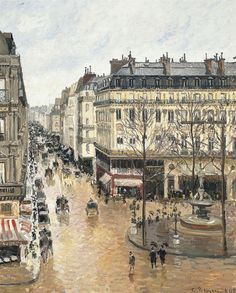SAN DIEGO, USA – Nazi-looted painting won’t be returned to California family, judge rules
The cityscape, titled “Rue Saint-Honoré, Apres-midi, Effet de Pluie” (“Rue Saint-Honoré in the Afternoon. Effect of Rain”
.

Claude Cassirer, before his death, and his wife, Beverly, are seen in 2010 with a copy of a painting by Impressionist Camille Pissarro. (Allen J. Schaben / Los Angeles Times)
.
The back-and-forth legal drama over an Impressionist masterpiece that hangs in a Spanish museum has seemingly come to the end of the road for a San Diego family, who is left with nothing to show for their decade-long battle to reclaim the artwork they say was seized from them by Nazis 80 years ago.
. .>.
ADS by Cloud 9:
.
– SPACE RESERVE FOR YOUR ADVERTISEMENT –
.
.
A Los Angeles judge on Tuesday ruled against the Cassirer family — who for years had tried to reclaim the painting taken from them during an escape from Germany during the Holocaust — saying the looted artwork belongs to the international museum.
The canvas has a storied past. In 1939, Nazi troops forced the Jewish family of Lilly Cassirer to trade a Camille Pissarro painting for her family’s freedom while escaping from Germany before the start of World War II. The piece had been in her family for nearly four decades, after her father purchased it directly from Pissarro’s art dealer at the turn of the century.
The cityscape, titled “Rue Saint-Honoré, Apres-midi, Effet de Pluie” (“Rue Saint-Honoré in the Afternoon. Effect of Rain”), was considered a lost family heirloom when in 1958, the German government paid Cassirer $13,000 in reparations. But in 2000, a family friend discovered the canvas was hanging in Madrid’s Museo Nacional Thyssen-Bornemisza. It has been there for more than 25 years.
Lilly Cassirer died decades before the discovery and would never know about the fate of the painting, how it ended up in Spain, the ensuing fight for its possession or the recent ruling by U.S. District Judge John F. Walter in Los Angeles.
Pissarro’s Parisian street scene from 1897, valued at $30 million, has been at the center of a fight between the Spanish museum and Cassirer’s descendants for more than a decade. The grandson she raised, Claude Cassirer, filed a lawsuit in 2005, fighting to regain ownership of the art that had graced the wall of his grandmother’s lavishly furnished parlor in Berlin in the early part of the 20th century.
ADS by Cloud 9:
.
– SPACE RESERVE FOR YOUR ADVERTISEMENT –
.
“My grandmother never knew what happened to the painting,” he told The Times in a 2010 interview.
When he died several years later, the suit passed to his daughter. Since her death last year, it’s been in the hands of his son, David Cassirer.
After crisscrossing art dealers throughout the United States, the painting ended up in the hands of Baron Hans-Heinrich Thyssen-Bornemisza, a Swiss art collector and descendant of a German steel empire family, in 1976.
The judge’s ruling states that the baron “was undoubtedly aware that there had been massive looting of art by the Nazis and it was ‘generally known’ that the Baron’s family (although not the Baron specifically) had a history of purchasing art and other property that had been confiscated by the Nazis.”
ADS by Cloud 9:
.
– SPACE RESERVE FOR YOUR ADVERTISEMENT –
.
When the Spanish government purchased the baron’s art collection years later, Pissarro’s painting made its way to the museum in Madrid.
Prior to the purchase, “the Kingdom of Spain assumed that the Baron acted in good faith, because ‘we simply had no reason to believe otherwise,’ ” Walter said. Had that not been the case, the ruling suggests that Spain should have accepted the original owner as the rightful heir.
We respectfully disagree that the court cannot force the Kingdom of Spain to comply with its moral commitments..
– STEVE ZACK, THE ATTORNEY FOR CASSIRER
,
ADS by Cloud 9:
.
– SPACE RESERVE FOR YOUR ADVERTISEMENT –
.
.
Walter ruled that the court could not force the museum to comply with its “moral commitments.” Because the case was not based on moral ethics, the ruling favored the museum as the lawful owner of the Pissarro.
Following Cassirer’s suit to regain ownership of the painting, lawyers argued that the family’s right to claim ownership over the painting had expired. But a judge’s initial ruling in favor of the museum was later overturned by an appeals court.
The case moved to Walter in Los Angeles, who first ruled in favor of the museum in 2016. That case was overturned once again and sent back for a retrial before Tuesday’s ruling.
Thaddeus Stauber, the museum’s U.S. attorney, thinks the latest decision puts an end to the ongoing battle over the piece of art.
“We are very pleased with the court’s decision that the Thyssen-Bornemisza Collection Foundation’s ownership of the Camille Pissarro painting stands, and that after a full trial on the merits, the Foundation’s ownership has been confirmed,” he said.
ADS by Cloud 9:
.
– SPACE RESERVE FOR YOUR ADVERTISEMENT –
.
.
.
“As a lawyer who has been involved in this case for 14 years, I’m pleased that the court did conduct a full trial. We now have a decision on the lawful owner, and that should put an end to it,” he said.
Cassirer’s attorney, Steve Zack, however, doesn’t agree with the ruling.
“We respectfully disagree that the court cannot force the Kingdom of Spain to comply with its moral commitments,” he said.
Several cases have been filed in recent years in U.S. courts by the American families of European Jews. Last year, an appeals court upheld Walter’s ruling from 2016 that the Norton Simon Museum in Pasadena rightfully owned Renaissance paintings of Adam and Eve that Nazis took from a Dutch Jewish art dealer because the Dutch government was the technical owner when it sold the works.
Of the roughly 600,000 paintings thought to have been stolen by Nazis during the Holocaust, about 100,000 are still missing, said Stuart E. Eizenstat, a State Department advisor on Holocaust-era issues and a leading figure in the campaign to return looted art.
Colleen Shalby
ADS by Cloud 9:
.
– SPACE RESERVE FOR YOUR ADVERTISEMENT –
.
.
.

All photographs, news, editorials, opinions, information, data, others have been taken from the Internet ..aseanews.net | [email protected] | For comments, Email to : Goldenhands Arts Club | [email protected]









